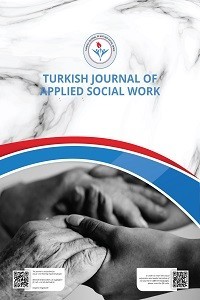THE STATISTICAL DATA OF FEMICIDE IN THE WORLD AND TURKEY DOES REFLECT THE TRUTH?
THE STATISTICAL DATA OF FEMICIDE IN THE WORLD AND TURKEY DOES REFLECT THE TRUTH?
The development of human beings remains at the level of technology and regresses in the field of civilization. The biggest indicator of this situation is the existence of violence against women in all developed or developing countries and its increasing day by day. Violence against women is multidimensional. If violence against women is not stopped, the deaths of women will increase day by day. To make the number of murders of women visible, the word femicide is used instead of the word homicide. Generally speaking, “femicide” refers to the killing of females mainly because they are female.
The purpose of this study is to examine national and international statistics on domestic violence and femicide in the world and our country from many original sources, provide current and accurate information to the world and in Turkey, to deal with the issue within the scope of international agreements and laws, interpreting positive studies and missing issues from a social service perspective and suggesting solutions. In this study, one of the qualitative research methods, the method of examining written documents were used. Documents such as national and international reports, books, researches, articles, statistics on the subject of the research have been systematically analyzed by checking their originality.
In the document reviews conducted within the scope of the research, it is seen that the databases of the countries are not very healthy in the number of cases of violence against women and the number of femicides. Therefore, statistics of international organizations cannot go beyond estimates. Especially, it is seen that the number of femicides in our country is gradually increasing. It is noteworthy that the relevant institutions do not include the suspicious deaths of women in their statistics. Turkey, under Istanbul Convention, has made great strides in preventing violence against women. However, it is thought that withdrawing from Istanbul Convention may cause these gains to erode over time.
___
- Altınay, A. G. & Arat, Y. (2007). Research report violence against women in Turkey, Ankara: TÜBİTAK, http://research.sabanciuniv.edu/7029/1/TurkiyedeKadinaYonelikSiddet.pdf
- Barker, R. (1999). The social work dictionary, 4th eds. Washington, DC: NASW Press.
- Campbell, J. C. (1992). “If I can't have you, no one can”: Power and control in the homicide of female partners. In J. Radford & D.E.H. Russell (Eds.), Femicide: The politics of woman killing (pp. 99-113). New York: Twayne.
- Corradi, C., Marcuello-Servós, C., Boira, S., & Weil, S. (2016). Theories of Femicide and Their Significance for Social Research. Current Sociology, 64(7), 975–995: 1-21.
- Cumhuriyet Newspaper, (November 16, 2019). https://www.cumhuriyet.com.tr/haber/icisleri-bakani-soylu-kadina-yonelik-artan-siddeti-kabullendi-1702396
- Istanbul Convention (2011). Council of Europe Convention on preventing and combating violence against women and domestic violence. https://rm.coe.int/168008482e
- Levy, B. (2008). Women and Violence. Berkeley: Seal Press.
- McCarry, N. L. (2016). Same old story? Children and young people's continued normalization of men's violence against women. Feminist Review, 112(1): 128-143.
- Mojab, N. A. (2006). Violence in the name of honor: Theoretical and political approaches. der. Shahrzad Mojab, Nahla Abdo. İstanbul: İstanbul Bilgi University Publications. National Violence Against Women Survey (NVAWS, 2000). The full report of the prevalence, ıncidence, and consequences of violence against women, U.S. Department of Justice Office of Justice Programs. Washington, DC
- Nowak, K.L., Krcmar, M. &, Farrar, K.M (2008). The causes and consequences of presence: Considering the influence of violent video games on presence and aggression Presence: Teleoperators and Virtual Environments, 17 (3), 256-268.
- Research on Domestic Violence against Women in Turkey (2014). http://www.hips.hacettepe.edu.tr/siddet2014/rapor/ozetraporturkceweb.pdf
- Russell, D. (2001). Introduction: The politics of femicide. Femicide in Global Perspective. ed. Roberta A. Harmes, Diana E. H. Russell. New York & Londra: Teacher Collage Press: p. 3-11. Statista (2021a). Countries with a higher number of femicide in the European Union in 2018 https://www.statista.com/statistics/1096116/femicide-in-europe-in-2018/ Statista (2021b). Number of femicide in the U.S. by state 2018 https://www.statista.com/statistics/327462/women-murdered-by-men-united-states/
- Statista (2021c). Latin America: number of femicide victims 2019, by country https://www.statista.com/statistics/827170/number-femicide-victims-latin-america-by-country/
- (Statista, 2021d). Number of femicides in Italy 2002-2019 https://www.statista.com/statistics/782029/share-of-women-murdered-by-their-partners-or-ex-partners-in-italy/
- Taştan C. & Yıldız A. K. (2019). Women's Murders in the world and Turkey 2016- 2017- 2018 Data and Analysis, Ankara: Police Academy Publications.
- The femicide platform (2021). Femicide in Turkey. https://kadincinayetleri.org/
- The Hope Foundation (2021). Femicide in Turkey. http://umut.org.tr/umut-vakfi-2020-yili-kadin-cinayetleri-haritasi/
- The World Bank (2021). UN Office on Drugs and Crime's International Homicide Statistics database. https://data.worldbank.org/indicator/VC.IHR.PSRC.FE.P5
- UN Women, (2021). Facts and figures: Ending violence against women https://www.unwomen.org/en/what-we-do/ending-violence-against-women/facts-and-figures
- UN Women & UNDP (2020). COVID-19 Global Gender Response Tracker. https://data.undp.org/gendertracker/ United Nations Economic and Social Affairs (2015). The World’s Women 2015, Trends and Statistics, https://www.un.org/en/development/desa/news/2015.html
- United Nations Office on Drugs and Crime (2019). Global Study on Homicide 2019, p. 10. https://www.unodc.org/unodc/en/data-and-analysis/global-study-on-homicide.html
- We will stop the femicide platform (2021). Femicide. http://kadincinayetlerinidurduracagiz.net/
- WHO (2012). Understanding and addressing violence against women: Femicide. https://apps.who.int/iris/bitstream/handle/10665/77421/WHO_RHR_12.38_eng.pdf
- WHO (2018). World health statistics 2018: monitoring health for the SDGs, sustainable development goals, https://apps.who.int/iris/bitstream/handle/10665/272596/9789241565585-eng.pdf
- WHO, (2021). Homicide estimates by country, WHO estimates of the number of femicides, https://apps.who.int/gho/data/view.main.VIOLENCEHOMICIDEv
- World Bank Group, (2020). Women, Business and the Law 2020. https://wbl.worldbank.org/en/wbl
- World Vision (Nov 17, 2020). Femicide: a global tragedy, no matter your gender https://www.worldvision.ca/stories/gender-equality/femicide-a-global-tragedy-no-matter-your-gender#Where is femicide rates highest?
- Yıldırım, A. & Şimşek, H. (2008). Qualitative research methods in the social sciences. Ankara: Seçkin Publications.
- ISSN: 2651-4923
- Başlangıç: 2018
- Yayıncı: Mehmet Zafer DANIŞ
Sayıdaki Diğer Makaleler
THE STATISTICAL DATA OF FEMICIDE IN THE WORLD AND TURKEY DOES REFLECT THE TRUTH?
Gülcan URHAN, İnci KAYIN, İsmail NALBANTOĞLU
A DEMOGRAPHIC STUDY ON SYRIANS UNDER TEMPORARY PROTECTION: THE CASE OF ANKARA
THE RELATIONSHIP BETWEEN SOCIAL WORK ACADEMIC DISCIPLINE-OCCUPATION AND DEMOCRACY
A COMMUNITY-BASED RISK REDUCTION AND RECOVERY PROGRAM; A MODEL FOR THE SYRIAN REFUGEE CRISIS
